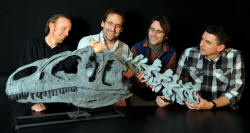- News & information
- About
- History
- George V. Voinovich
- George V. Voinovich Collection
- Calendar
- How to Find Us
- News
- Archives
- Photojournalism Fellowship Project
- Photo Essays
- Current Fellow
- Previous Fellows
- Reports and Publications
- Archives
- Students
- Prospective
- Center for Entrepreneurship
- Environmental Studies
- HTC/Voinovich School Scholars
- Master of Public Administration
- Current
- HTC/Voinovich School Scholars
- Center for Entrepreneurship
- Environmental Studies
- Master of Public Administration
- Alumni
- Contact
- School Leadership
- Strategic Partners Alliance
- Ohio University Public Affairs Advisory Committee
- Ohio University Public Affairs Advisory Committee
- Faculty and Fellows
- Faculty
- Visiting Professors
- Voinovich Fellows
- Professional Staff
| Lawrence M. Witmer,
PhD
|
 |
Engineering a dinosaur predator – Allosaurus feeding mechanics |
|
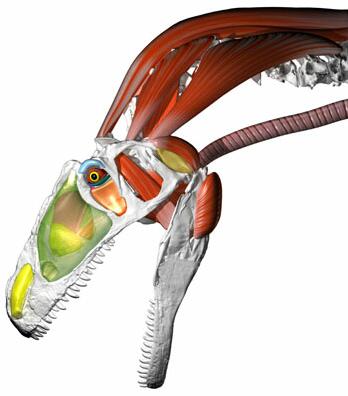 Common Language Summary
Common Language Summary
Engineering approaches shed new light on dinosaur feeding
styles.
Mechanical engineering and comparative anatomy merge with 3D
visualization to provide a fresh glimpse into the lifestyle of
the predatory dinosaur Allosaurus
. The famous skeleton of
the subadult Allosaurus
known as “Big Al,” collected from
the late Jurassic Morrison Formation (~150 million years old) in
Wyoming, formed the basis for an integrative study by four Ohio
University researchers. High-resolution replicas of the skull
and neck were CT-scanned and brought into the computer
environment for anatomical restoration and engineering
simulations. Based on information from the Visible Interactive
Dinosaur project, funded by the National Science Foundation, the
team modeled soft tissues such as the neck and jaw muscles, air
sinuses, and airway to arrive at realistic estimates of the mass
of the various parts and to calculate the sizes and attachments
of the muscles driving the system. The team then applied an
engineering approach borrowed from robotics called multibody
dynamics to run simulations of how Allosaurus
moved,
attacked, and stripped flesh from its prey. The results revealed
that, because of the locations of lighter air-filled regions and
heavier bony regions, Allosaurus
had a very flexible head
and neck with low rotational inertia, meaning that it that could
be accelerated in all directions with speed and control.
Moreover, the discovery of an usually placed neck muscle showed
that Allosaurus
removed flesh with a back-and-up tugging
motion more like that of a modern-day falcon than the
alligator-like lateral shake that was the rule for some other
predatory dinosaurs, such as T. rex
. This approach
combining detailed soft-tissue reconstruction with sophisticated
engineering-based modeling opens a new window to the past.
• Download a PDF of the published article:
Snively, Eric, Cotton, John R., Ridgely, Ryan, and Witmer, Lawrence M. 2013. Multibody dynamics model of head and neck function in Allosaurus (Dinosauria, Theropoda), Palaeontologia Electronica Vol. 16, Issue 2; 11A 29p.
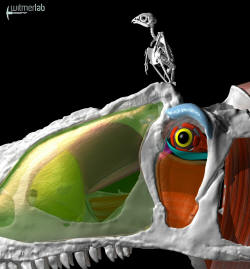
A modern-day kestrel (a small falcon) is perched atop the skull of the Jurassic predatory dinosaur Allosaurus. A key finding of the new study is that Allosaurus had a feeding style similar to falcons. In both cases , tearing flesh from carcasses involved grasping meat with the jaws and tugging back and up with the neck and body. Courtesy of WitmerLab at Ohio University.
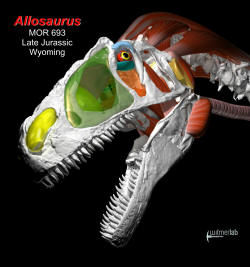
Skeleton and soft tissues of
the head and neck of the late Jurassic predatory dinosaur Allosaurus
. Courtesy of WitmerLab at Ohio University.
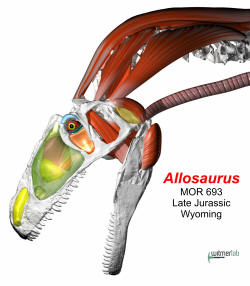
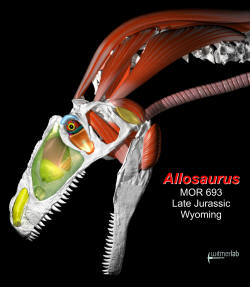
Skeleton and soft tissues of
the head and neck of the late Jurassic predatory dinosaur Allosaurus
. Courtesy of WitmerLab at Ohio University.
Head and neck movements of the Jurassic predatory dinosaur Allosaurus
. Courtesy of WitmerLab at Ohio University.
• Download a 36 MB QuickTime version (HD: 1080x1080)
• Download a 21 MB QuickTime version (720x720)
• Download a 12 MB QuickTime version (480x480)

The "Big Al" Quarry in 1991. Excavation of the Allosaurus skeleton (MOR 693) used in this study. See http://bit.ly/YYsfS8 for more info on the specimen. The skull is at upper right. Courtesy of the Bureau of Land Management Wyoming and the Museum of the Rockies.
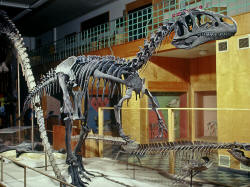
Mounted complete skeleton of "Big Al," the specimen of Allosaurus used in this study. See http://bit.ly/YYsfS8 for more info on the specimen. Courtesy of the Bureau of Land Management Wyoming and University of Wyoming Geological Museum.
EMBARGOED FOR RELEASE TUESDAY, 21 MAY 2013, 2:00 PM EDT
Allosaurus
fed
more like a falcon than a crocodile, new study finds
Engineering, anatomy work reveals differences in dinosaur
feeding styles
ATHENS, Ohio (May 21, 2013)—The mighty T. rex may have thrashed its massive head from side to side to dismember prey, but a new study shows that its smaller cousin Allosaurus was a more dexterous hunter and tugged at prey more like a modern-day falcon.
“Apparently one size doesn’t fit all when it comes to dinosaur feeding styles,” said Ohio University paleontologist Eric Snively, lead author of the new study published today in Palaeontologia Electronica . “Many people think of Allosaurus as a smaller and earlier version of T. rex , but our engineering analyses show that they were very different predators.”
Snively led a diverse team of Ohio University researchers, including experts in mechanical engineering, computer visualization and dinosaur anatomy. They started with a high-resolution cast of the five-foot-long skull plus neck of the 150-million-year-old predatory theropod dinosaur Allosaurus , one of the best known dinosaurs. They CT-scanned the bones at O’Bleness Memorial Hospital in Athens, which produced digital data that the authors could manipulate in a computer.
Snively and mechanical engineer John Cotton applied a specialized engineering analysis borrowed from robotics called multibody dynamics. This allowed the scientists to run sophisticated simulations of the head and neck movements Allosaurus made when attacking prey, stripping flesh from a carcass or even just looking around.
“The engineering approach combines all the biological data—things like where the muscle forces attach and where the joints stop motion—into a single model. We can then simulate the physics and predict what Allosaurus was actually capable of doing,” said Cotton, an assistant professor in the Russ College of Engineering and Technology.
To figure out how Allosaurus de-fleshed a Stegosaurus , the team had to “re-flesh” Allosaurus . The anatomical structure of modern-day dinosaur relatives, such as birds and crocodilians, combined with tell-tale clues on the dinosaur bones, allowed Snively and anatomists Lawrence Witmer and Ryan Ridgely to build in neck and jaw muscles, air sinuses, the windpipe and other soft tissues into their Allosaurus 3D computer model.
“Dinosaur bones simply aren’t enough,” said Witmer, Chang Professor of Paleontology in the Heritage College of Osteopathic Medicine and principal investigator on the National Science Foundation’s Visible Interactive Dinosaur Project that provided funding for this research. “We need to know about the other tissues that bring the skeleton to life.”
A key finding was an unusually placed neck muscle called longissimus capitis superficialis. In most predatory dinosaurs, such as T. rex , which Snively studied previously, this muscle passed from the side of the neck to a bony wing on the outer back corners of the skull.
“This neck muscle acts like a rider pulling on the reins of a horse’s bridle,” explained Snively. “If the muscle on one side contracts, it would turn the head in that direction, but if the muscles on both sides pull, it pulls the head straight back.”
But the analysis of Allosaurus revealed that the longissimus muscle attached much lower on the skull, which, according to the engineering analyses, would have caused “head ventroflexion followed by retraction.”
“ Allosaurus was uniquely equipped to drive its head down into prey, hold it there, and then pull the head straight up and back with the neck and body, tearing flesh from the carcass … kind of like how a power shovel or backhoe rips into the ground,” Snively said.
In the animal world, this same de-fleshing technique is used by small falcons, such as kestrels. Tyrannosaurs like T. rex , on the other hand, were engineered to use a grab-and-shake technique to tear off hunks of flesh, more like a crocodile.
But the team’s engineering analyses revealed a cost to T. rex ’s feeding style: high rotational inertia. That large bony and toothy skull perched at the end of the neck made it hard for T. rex to speed up or slow down its head or to change its course as it swung its head around.
Allosaurus, however, had a relatively very light head, which the team discovered as they restored the soft tissues and air sinuses.
Having a lot of mass sitting far away from the axis of head turning, as in T. rex , increases rotational inertia, whereas having a lighter head, as in Allosaurus , decreases rotational inertia, the researchers explained. An ice skater spins faster and faster as she tucks her arms and legs into her body, decreasing her rotational inertia as the mass of her limbs moves closer to the axis of spinning.
“ Allosaurus , with its lighter head and neck, was like a skater who starts spinning with her arms tucked in,” said Snively, “whereas T. rex , with its massive head and neck and heavy teeth out front, was more like the skater with her arms fully extended … and holding bowling balls in her hands. She and the T. rex need a lot more muscle force to get going.”
The end result is that Allosaurus was a much more flexible hunter that could move its head and neck around relatively rapidly and with considerable control. That control, however, came at the cost of brute-force power, requiring a de-fleshing style that, like a falcon, recruited the whole neck and body to strip flesh from the bones.
The Ohio University team will continue to use their engineering approach to explore additional differences in dinosaur feeding styles.
The scientific article is freely available (open-access) on the Palaeontologia Electronica site ( http://palaeo-electronica.org ). The research was funded by National Science Foundation grants to Lawrence Witmer and Ryan Ridgely, as well as by the Department of Mechanical Engineering in the Russ College of Engineering and Technology (John Cotton and Eric Snively) and the Heritage College of Osteopathic Medicine (Witmer, Ridgely, and Snively).
Editors:
• Download the article here:
Downloads/2013_Snively_et_al._Allosaurus_feeding_mechanics_PE.pdf
• Related images and animations can be downloaded from the
WitmerLab site:
Allosaurus_mechanics.htm
• A fact sheet can be accessed here:
Downloads/Allosaurus_feeding_mechanics_facts_and_graphics.pdf
Contacts
(all Eastern Standard Time):
1. Eric Snively, 740-591-8928,
es180210@ohio.edu
2. Lawrence Witmer, 740-591-7712,
witmerL@ohio.edu
This project was funded by grants from the National Science Foundation .
Contact Information:
(740) 593–9381 | Building 21, The Ridges
Ohio University Contact Information:
Ohio University | Athens OH 45701 | 740.593.1000 ADA Compliance | © 2018 Ohio University . All rights reserved.
















